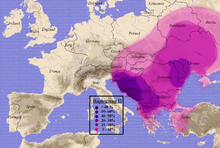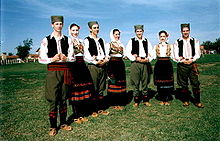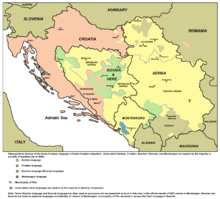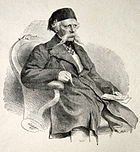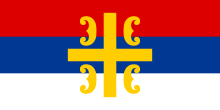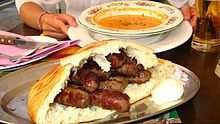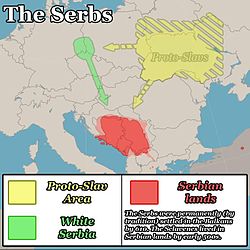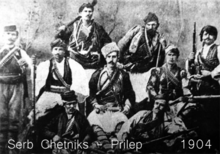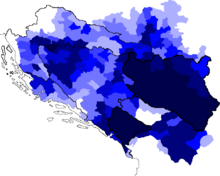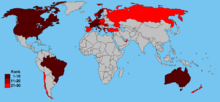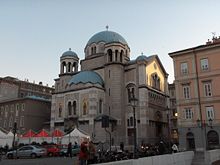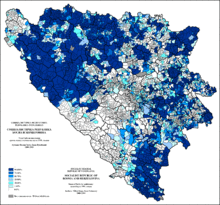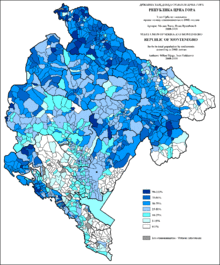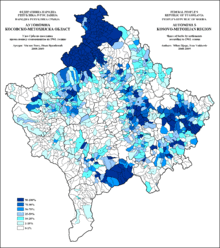- Serbs
-
Serbs
Срби, Srbi


 Dušan the Mighty
Dušan the Mighty


 KarađorđeVuk Karadžić
KarađorđeVuk Karadžić







Total population 10.5 milliona Regions with significant populations  Serbia 6,212,838b
Serbia 6,212,838bRest of the Balkansc  Bosnia-Herzegovina
Bosnia-Herzegovina
 Republika Srpska
Republika Srpska1,711,577 (2009)
(96.8%)[1]  Croatia
Croatia201,631 (2001) [2]  Montenegro
Montenegro178, 110 (2011) [3]  Slovenia
Slovenia38,964 (2002) [4]  Macedonia
Macedonia35,939 (2002) [5]  Greece
Greece10,000 (2001) [6]  Albania
Albania4,000 (2000) [7] Rest of Europe  Germany
Germany568,240 (2004) [8]  Austria
Austria350,000 (2008) [9]  Switzerland
Switzerland186,000 (2008) [10]  Sweden
Sweden120,000 (2008) [11]  France
France70-100,000 (2008) [12]  Italy
Italy70,000 (2008) [13]  United Kingdom
United Kingdom70,000 (2005) [14]  Denmark
Denmark64,000 (2008) [15]  Romania
Romania22,518 (2002) [16]  Belgium
Belgium19,857 (2008) [17]  Spain
Spain10,000 (2008) [18]  Norway
Norway9,064 (2007) [19]  Luxembourg
Luxembourg7,581 (2008) [20]  Hungary
Hungary7,350 (2002) [21]  Turkey
Turkey4,600 (2007)d [22]  Russia
Russia4,156 (2002) [23] North America  United States
United States172,874 (2007)e [24]  Canada
Canada72,690 (2006) [25] Africa, Asia and Oceania  Australia
Australia95,364 (2009) [26] Languages Religion Predominantly Orthodox Christianity
Related ethnic groups Footnotes A Higher estimations exist.
B excluding Kosovo.
C Besides Serbia, at least 2,120,000 Serbs live in other Balkan countries according to the Diaspora ministry.[28]
D An estimated 315,000 can claim Serbian descent.[29]
E 328,547 declared as Yugoslavs.[30]The Serbs (Serbian: Срби, Srbi, pronounced [ˈsr̩bi]) are a South Slavic ethnic group of the Balkans and southern Central Europe. Serbs are located mainly in Serbia, Montenegro and Bosnia and Herzegovina, and form a sizable minority in Croatia, the Republic of Macedonia and Slovenia. Likewise, Serbs are an officially recognized minority in both Romania and Hungary, as well as in Albania, the Czech Republic and Slovakia.[31] There is also a large Serbian diaspora presence in Western Europe, particularly in Germany, Sweden, Switzerland and Austria, as well as in France and Italy. More than a million people of Serbian origin live in German-speaking countries:[32] Luxembourg (1%),[33] Austria (1,8%),[9] Switzerland (1%), and Germany (~1%).[34]
Contents
Ethnology
The Serbs are a Slavic people, specifically of the South Slavic subgroup, which has its origins in the 6th and 7th century communities developed in Southeastern Europe (see Great Migration). Slav raids on Eastern Roman territory are mentioned in 518, and by the 580s they had conquered large areas referred to as Sclavinia (transl. Slavdom, from Sklavenoi – Σκλαυηνοι, the early South Slavic tribe which is eponymous to the current ethnic and linguistic Indo-European people).[35] In 649, Constantine III relocates conquered Slavs "from the Vardar" to Gordoservon (Serb habitat). Among communities part in the Serb ethnogenesis are the Romanized Paleo-Balkan tribes of Illyrians, Thracians and Dacians, Celts, Greek colonies and Romans.
In 822, the Serbs are mentioned as "inhabiting the larger part of Dalmatia" (Serbian lands), and Emperor Constantine VII (r. 913–959) writes in his work "Administration of the Empire"[36] (De Administrando Imperio) about the Serbs, mentioning the White Serbs that "migrated from Βοϊκι" and formed a principality, as well as an early chronological list of Serbian monarchs starting from the 7th century. The Serbs subsequently developed a Byzantine-Slavic culture, like the neighbouring Bulgarians (who derive their ethnonym from the Turkic Bulgars, founders of their nation). The establishment of Christianity as state-religion took place around 869 AD, during the rule of Emperor Basil I (r. 867–886). The Serbian Orthodox Church was established in 1219. By the time of the Serbian Empire, the Serbo-Byzantine cultural sphere had besides the initial territories much of the Macedonia region and Epirus.
The loss at Battle of Kosovo in 1389 (see Ottoman wars in Europe) marks the beginning of the fall of the Serbian monarchies, and prompts the migration of Serbs from their lands in the south towards the Christian lands i.e. north of the Ottoman borders, crossing rivers Danube and Sava settling in Central Europe (today's Vojvodina, Slavonia, Transylvania and Hungary proper). The Great Serbian Migrations refers to the relocation of peoples in two waves in the 17th century of tens of thousands Serbian families. Apart from the Habsburg Empire, thousands were attracted to Imperial Russia (see Nova Serbia and Slavo-Serbia).
Exiled Serb military became mercenaries in European armies; Hussars (light cavalry in Hungary and Poland), Seimeni (infantry in Moldavia and Wallachia). Serbs organized several revolts and guerilla units, planned both inside and outside the Ottoman borders. The Hajduks and Uskoks were groups of freedom fighters, the Monasterli's Serbs was a branch of the Austrian army under Leopold I. The Serbian revolution began in 1804.
Related
Although the Serbs and Bulgarians share Slavic kinship, Orthodox Christianity and cultural traits, the two peoples have been relatively hostile against each other in history and were early on understood as distinct ethnic groups. The two are divided by the Southeastern versus Southwestern dialectal groups, although a large transitional dialectal area covers Southeastern Serbia, Western Bulgaria and Macedonia.
The Croats, who are mentioned in De Administrando as living adjacent to the Serbs, have clear distinctions of predominant sphere of influence; Croats are Roman Catholic, and are historically linked with the Holy Roman Empire from the early stage (Western Roman Empire); Italy, Austria and Hungary. A majority of the two ethnic groups have lived together in the Habsburg Empire and Venetian territories throughout centuries, so links between the two nations have been maintained in that respect through common history.
The dialects of Serbia, Bosnia & Herzegovina, Croatia and Montenegro are virtually the same language (see Serbo-Croatian).
Genetics
Y-chromosomal haplogroups identified among the Serbs from Serbia and Bosnia-Herzegovina are the following: I2a-P37.2 (with frequencies of 29.20 and 30.90%, respectively), E1b1b1a2-V13 (20.35 and 19.80%), R1a1-M17 (15.93 and 13.60%), R1b1b2-M269 (10.62 and 6.20%), K*-M9 (7.08 and 7.40%), J2b-M102 (4.40 and 6.20%), I1-M253 (5.31 and 2.5%), F*-M89 (4.9%, only in B-H), J2a1b1-M92 (2.70%, only in Serbia), and several other uncommon haplogroups with lesser frequencies.[37][38][39]
I2a-P37.2 is the most prevailing haplogroup, accounting for nearly one-third of Serbian Y-chromosomes. Its frequency peaks in Herzegovina (64%), and its variance peaks over a large geographic area covering B-H, Serbia, Hungaria, Czech Republic, and Slovakia. Geneticists estimate that I2a-P37.2 originated some 10,000 years before present (ybp) in the Balkans, from where it began to expand to Central, Eastern, and Southern Europe about 7000 ybp. It is the second most predominant Y-chromosomal haplogroup in the overall Slavic gene pool. Slavic migrations to the Balkans in the early Middle Ages contributed to the frequency and variance of I2a-P37.2 in the region.[37]
E1b1b1a2-V13 is the second most prevailing haplogroup, accounting for one-fifth of Serbian Y chromosomes. Its frequency peaks in Albania at 24% (among Kosovo Albanians it is 44% due to genetic drift), and is also high among Greeks, Romanians, Macedonian Slavs, and Bulgarians. It is rare among other Slavs, and moderate frequencies of it are found in southern Italy and Anatolia.[37][39] E-V13 probably originated in the southern Balkans about 9000 ybp. Its ancestral haplogroup, E1b1b1a-M78, could be of a northeast African origin.[39]
R1a1-M17 accounts for about one-seventh to one-sixth of Serbian Y-chromosomes. Its frequency peaks in Poland (56.4%) and Ukraine (54.0%), and its variance peaks in northern Bosnia.[37] It originated around 20,000 ybp likely in southern Siberia, and some of its bearers migrated to the Balkans 10,000 to 13,000 ybp. About 5000 to 6000 ybp, they began to migrate from the Balkans to the west toward the Atlantic, to the north toward the Baltic Sea and Scandinavia, to the east to the Russian plains and steppes, and to the south to Asia Minor.[40] It became the most predominant haplogroup in the general Slavic paternal gene pool. The variance of R1a1 in the Balkans might have been enhanced by infiltrations of Indo-European speaking peoples between 2000 and 1000 BC, and by the Slavic migrations to the region in the early Middle Ages.[37][38] A descendant lineage of R1a1-M17, R1a1a7-M458, which has the highest frequency in central and southern Poland (30%, more than half of total R1a1 there), is also observed among East Slavic and Finno-Ugric peoples, but it is very rare among South Slavs, including Serbs.[41]
R1b1b2-M269 is moderately represented among the Serb males (6–10%). It has its frequency peak in Western Europe (90% in Wales), but a high frequency is also found in the Caucasus among the Ossetians (43%).[37] It was introduced to Europe by farmers migrating from western Anatolia, probably about 7500 ybp. Serb bearers of this haplogroup are in the same cluster as Central and East European ones, as indicated by the frequency distributions of its sub-haplogroups with respect to total R-M269. The other two clusters comprise, respectively, West Europeans and a group of populations from Greece, Turkey, the Caucasus and the Circum-Uralic region.[42]
J2b-M102 and J2a1b1-M92 have low frequencies among the Serbs (6–7% combined). Various other lineages of haplogroup J2-M172 are found throughout the Balkans, all with low frequencies. Haplogroup J and all its descendants originated in the Middle East. It is proposed that the Balkan Mesolithic foragers, bearers of I-P37.2 and E-V13, adopted farming from the initial J2 agriculturalists who colonized the region about 7000 to 8000 ybp, transmitting the Neolithic cultural package.[39]
An analysis of molecular variance based on Y-chromosomal STRs showed that Slavs can be divided into two distinct groups: one encompassing West Slavs, East Slavs, Slovenes, and western Croats, and the other encompassing Macedonian Slavs, Serbs, Bosniaks, and northern Croats (the latter six populations are South Slavic speakers). This distinction could be explained by a genetic contribution of pre-Slavic Balkan populations to the genetic heritage of South Slavs belonging to the latter group.[43] Principal component analysis of Y-chromosomal haplogroup frequencies among the three ethnic groups in Bosnia and Herzegovina, Serbs, Croats, and Bosniacs, showed that Serbs and Bosniacs are genetically closer to each other than either of them is to Croats.[38]
According to Serbian physical anthropologist Živko Mikić, the medieval population of Serbia developed a phenotype that represented a mixture of Slavic and indigenous Balkan Dinaric traits. Mikić argues that the Dinaric traits, such as brachycephaly and a bigger average height, have been since then becoming predominant over the Slavic traits among Serbs.[44]
Name and etymologies
Main article: Names of the SerbsPart of a series of articles on
Serbs
 Former Yugoslavia:
Former Yugoslavia:
Serbia (Kosovo • Vojvodina)
Bosnia & Herzegovina (RS)
Croatia
Republic of Macedonia
Montenegro
Slovenia
Other:
Albania · Greece · RomaniaAustria · France · Germany
Hungary · Italy · Sweden · Switzerland
United Kingdom
North America
Canada · United States
Oceania
Australia · New Zealand
South America
Argentina · Brazil · ChileReligion
(Slava · Christmas traditions)
Kinship · Clans
Art · Architecture · Music · Cinema
Costume · Symbols
Literature · Epic poetry
Cultural Heritage sites
Sport · Cuisine · DancesRelated nationsThe ethnonym Serbs is thought to be first mentioned by Tacitus in 50 AD, Pliny the Elder in 77 AD (Naturalis Historia) and Ptolemy in his Geography 2nd century AD, who mention the Sarmatian tribe of Serboi of the North Caucasus and Lower Volga.[45] Roman historian Ammianus Marcellinus (325–391) referred to the Carpathians as "Montes Serrorum" in his works, according to some, connected to the Serbs.[46] The works of Vibius Sequester also mention the Serbs.[47] Procopius uses the name Sporoi as an umbrella term for the Slavic tribes of Antes and Sclaveni, it is however not known whether the Slavs used this designation for themselves or he himself coined the term, it has been theorized however that the name is corruption of the ethnonym Serbs.[47][48]
The Serb ethnonym is written as Σερβlοι (Servloi), Sorabos, Surbi, Sorabi in early medieval sources.[49] De Administrando Imperio mentions the realm of the Unknown Archont and his descendants (House of Vlastimirović) as Servlia.[36][45] A mythological homeland was written as Boiki (derived from Proto-Slavic *bojь. = battle, war, fight), also, the town of Servia received its name from the temporary inhabitants – the Serbs.[36][45] According to the Tale of Bygone Years, the first Russian chronicle, Serbs are among the first five Slav peoples who were enumerated by their names.[50]
(< *serb-) is in the root of the Slavic word for "same" (modern исто - isto) in following languages: сербать - in Russian, Ukrainian, сербаць - in Belarussian, srbati - in Slovak, сърбам - in Bulgarian. серебати in Old Russian.[51] Scholars have suggested that the Indo-European root *ser- 'to watch over, protect', akin to Latin servare 'to keep, guard, protect, preserve, observe',[52] Old English searu 'weapons, armor, skill', Lithuanian sárgas 'watchman', are connected with the ethnonym.
Among other autonyms are Slavs, or the common historical demonyms Rascians (from Rascia>Ras[53]) or Docleans (from Doclea).[54] Historical exonyms include: Triballians and Dalmatians[55] used by medieval Byzantine writers, Illyrians[56] in the Austrian Empire (term for South Slavs). Among deemed derogatory terms are Vlachs, referring to the Orthodox Serbs in Habsburg and Austro-Hungarian proximity.
Famous Serbs
See also: List of Serbs Novak Djokovic, ranked 1st in tennis.
Novak Djokovic, ranked 1st in tennis.
Serbs have played a significant role in the development of the arts and sciences. Prominent individuals include the scientists Nikola Tesla, Michael I. Pupin, Jovan Cvijić, and Milutin Milanković; the renowned mathematician Mihailo Petrović and controversial co-author of Theory of Relativity Mileva Marić (Albert Einstein's first wife); Stevan Mokranjac and Stevan Hristić; the celebrated authors Borislav Pekić and Miloš Crnjanski; the prolific inventor Ogneslav Kostović Stepanović; the polymath Đura Jakšić; the famous sports stars like Ana Ivanović, Jelena Janković, Novak Djokovic, Predrag Stojaković, Dejan Stanković, Nemanja Vidić, Siniša Mihajlović, Dejan Bodiroga, Vlade Divac; actors Karl Malden (Mladen Sekulovich), Milla Jovovich, Rade Šerbedžija. Famous directors like Dušan Makavejev, Peter Bogdanovich and Emir Kusturica. The Serb ruler during the Middle Ages (see List of Serbian rulers), Stephen Nemanja, and his son, Saint Sava, founded the monastery of Hilandar for the Serbian Orthodox Church, one of the greatest and oldest Orthodox Christian monuments in the world. Famous singers Željko Joksimović and Marija Šerifović are from Serbia.
The mother of the last Byzantine Emperor, Constantine XI Paleologos Dragases, was a Serbian princess, Helena Dragash (Jelena Dragaš). Many Serbian Royal Families have had significant roles in European and Balkan history. Such as the House of Nemanjić, House of Mrnjavčević, House of Lazarević, House of Branković, House of Obrenović and House of Karađorđević. Some of the most venerated royal historical persons are Emperor Dusan, Tsar Lazar, Milos Obilic and Karageorge.
Vuk Stefanović Karadžić was a Serbian linguist and major reformer of the Serbian language. Nadežda Petrović is considered the most important Serbian female painter from the late 19th and early 20th century.
According to the National Enquirer, author Ian Fleming patterned James Bond after Duško Popov, a real life Serbian double agent nicknamed "Tricycle".
Gavrilo Princip, a Bosnian Serb nationalist, assassinated Archduke Franz Ferdinand on 28 June 1914, precipitating the crisis between Austria-Hungary and Serbia that led to the World War I.
Culture
Main article: Serbian cultureSerb culture has a wide spectra; besides the main [South] Slavic traits, the Byzantine (Eastern Roman) cultural heritage and Christianity (Serbian Orthodox Church) being prevalent. Western-Central European (Austro-Hungarian) cultural influence is higher in Vojvodina, Croatian Serbs and Bosnian Serbs, while the Serbs living in maritime regions (e.g. Bay of Kotor) have been influenced by Italian culture (Republic of Venice). The centuries under Ottoman rule have highly influenced with Oriental elements.
Following autonomy in 1817 and latter formal independence, there was a reawakening of Serbdom (Serbian identity/culture) followed by the emerging South-Slavic unity. Prior to that, Habsburg Vojvodina was the cultural bastion of the Serbian national identity. Socialist Realism was predominant in official art during the Socialist Federal Republic of Yugoslavia but recent decades have seen a growing influence from the West as well as traditional culture.
Language
Main article: Serbian language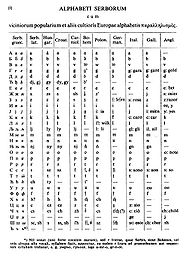 Serbian Cyrillic and Serbian Latin, from Comparative orthography of European languages. Source: Vuk Stefanović Karadžić "Srpske narodne pjesme" (Serbian folk poems), Vienna, 1841
Serbian Cyrillic and Serbian Latin, from Comparative orthography of European languages. Source: Vuk Stefanović Karadžić "Srpske narodne pjesme" (Serbian folk poems), Vienna, 1841
Serbs speak the Serbian language, a member of the South Slavic group of languages, specifically in the Southwestern Slavic group, with the Southeastern group containing Bulgarian and Macedonian. It is mutually intelligible with the standard Croatian and Bosnian languages (see Differences in standard Serbian, Croatian and Bosnian) and some linguists still consider it a sub-set of the Serbo-Croatian language, as they are all standardized on the Shtokavian dialect.
It is an official language in Serbia, Bosnia & Herzegovina (Republika Srpska), Montenegro and Romania, and a minority language in Croatia, Macedonia, Hungary and Slovakia.
Older forms of Serbian are Old Serbian, the redaction of Old Church Slavonic, and the Russo-Serbian variant, a version of the Church Slavonic language.
Serbian is the only European language with active digraphia, using both Cyrillic and Latin alphabets. Serbian Cyrillic was devised in 1814 by Vuk Karadžić, who created the alphabet on phonemic principles, the Cyrillic itself has its origins in Cyril and Methodius' transformation of the Greek script in the 9th century.
Loanwords in the Serbian language besides common internationalisms are mostly from Turkish, German and Italian, words of Hungarian origin are present mostly in the north and Greek words are predominant in the liturgy.
Two Serbian words that are used in many of the world's languages are "vampire" and "paprika". Common words of Serbian cuisine are "Slivovitz" and "ćevapčići". Paprika and Slivovitz are borrowed via German; paprika itself entered German via Hungarian. Vampire entered most West European languages through German-language texts in the early 18th century.
Naming system
Main article: Serbian name

Stefan Lazarević
(Lazarević) – son of Lazar of Serbia.Given names
A child is given a first name chosen by their parents but approved by the godparents of the child (the godparents rarely object to the parents' choice). The given name comes first, the surname last, e.g. "Željko Popović", where "Željko" is a first name and "Popović" is a family name. Female names end with -a, e.g. Dragan -> Dragana.
Popular names are mostly of Serbian (Slavic), Christian (Biblical), Greek and Latin origin.
- Serbian: Nenad, Dragan, Zoran, Goran and Slobodan.
- Greek: Nikola, Dimitrije, Đorđe, Aleksandar and Filip.
- Biblical: Jovan, Danilo, Petar, Pavle, Mihailo and Gavrilo.
- Latin: Marko, Srđan, Antonije and Miljan.
Surnames
Most Serbian surnames (like Bosniak, Croatian and Montenegrin) have the surname suffix -ić (pronounced Serbo-Croatian pronunciation: [itʲ] or [itɕ], Cyrillic: -ић). This is often transliterated as -ic or -ici. In English-speaking countries, Serbian names have often been transcribed with a phonetic ending, -ich or -itch. This form is often associated with Serbs from before the early 20th century: hence Milutin Milanković is usually referred to as Milutin Milankovitch.
The -ić suffix is a Slavic diminutive, originally functioning to create patronymics. Thus the surname Petrić signifies little Petar, similar to Mac ("son of") in Scottish & Irish, and O' (grandson of) in Irish names. It is estimated that some two thirds of all Serbian surnames end in -ić and some 80% of Serbs carry such a surname.
Other common surname suffixes are -ov or -in which is the Slavic possessive case suffix, thus Nikola's son becomes Nikolin, Petar's son Petrov, and Jovan's son Jovanov. Those are more typical for Serbs from Vojvodina. The two suffixes are often combined.
The most common surnames are Marković, Nikolić, Petrović, and Jovanović.
Religion
Main article: Serbian Orthodox Church His Holiness the Archbishop of Peć, Metropolitan of Belgrade and Karlovci, Serbian Patriarch Irinej.
His Holiness the Archbishop of Peć, Metropolitan of Belgrade and Karlovci, Serbian Patriarch Irinej.
 13th century Fresco from Visoki Dečani, Kosovo, Serbia
13th century Fresco from Visoki Dečani, Kosovo, Serbia
The Serbs are predominantly Orthodox Christian, and before Christianity, they adhered to Slavic paganism. The baptism of Serbs are said to have begun on the initiation of the Byzantine Empire, first during the reign of Emperor Heraclius (610–641), however the adoption of state-religion took place during the reign of Mutimir, who acknowledged suzerainty of Basil I in ca 869. After the Great Schism, which divided the Roman state church roughly in modern Bosnia, the greater parts of Serbian lands remained under Constantinople (East, i.e. Orthodox Church). In 1219, the Serbian Orthodox Church was established as the national church by Saint Sava. With the occupation of the Balkans by the Ottoman Empire, Islam was introduced, therefore there exist "Muslim Slavs"; Gorani, Bosniaks, Muslims by nationality etc, where Serbs traditionally live. Up until the 20th century, there were influential movements of Serb Catholics in Dubrovnik,[57] Muslim Serbs,[58] as well as Protestants in Vojvodina.
The Serbs have endured persecution at various times in history, mostly due to their religion. For example, the devshirme-system of the Ottoman Empire which saw Christian boys forcibly and permanently taken from their families to be trained and enrolled in Ottoman governmental work, becoming Turkified, Kara Khalil Chendereli, founder of the Janissaries, explained "The conquered are slaves of the conquerors, to whom their goods, their women, and their children belong as lawful possession..".[59] The Ottomans abolished the Serbian Church in 1766. During World War II, the Croatian nationalist movement known as Ustasha seized power in Croatia as an Axis power, Croatia had a notable Serb community which the Ustasha sought to eliminate: In their political programme it was explained that "⅓ of the Serbs were to be killed, ⅓ to be expelled and ⅓ forcibly converted to Catholicism" (see World War II persecution of Serbs). Estimates of civilian Serbs killed under the Ustasha regime exceed 500,000 (in the Jasenovac camp alone, at least 300,000).
Geographically, the Serbian Orthodox Church represents the westernmost bastion of Orthodox Christianity in Europe, which shaped its historical fate through contacts with Catholicism and Islam.
Symbols
Main article: National symbols of SerbiaFurther information: List of Serbian flags and Serb heraldry- The red-blue-white tricolour (a Slavic tricolour), is used as the Civil Flag of Serbia, as well as the ethnic or national flag of the Serb people. The official state flag has the tricolour with the Coat of Arms; the Serb eagle, which in turn has the Serb cross in the shield
- The Serb eagle, a white two-headed eagle, represents dual power and sovereignty (monarch and church), was the coat of arms of the Nemanjić Dynasty, adopted by the succeeding noble and royal families.
- The Serbian cross is based on the Byzantine cross, but where the Byzantine Cross held 4 Greek letter 'V' (or 'B') meaning King of Kings, ruling over Kings,[60] the Serbian cross turned the Byzantine "B" into 4 Cyrillic letters of 'S' (C) with little stylistic modification, for a whole new message. If displayed on a field, traditionally it is on red field, but could be used with no field at all.
Both the eagle and the cross, besides being the basis for various Serbian coats of arms throughout history, are bases for the symbols of various Serbian organizations, political parties, institutions and companies.
Serb folk attire varies, mostly because of the very diverse geography and climate of the territory inhabited by the Serbs. Some parts of it are, however, common:
- The traditional shoes Opanci (sing. Opanak), are recognizable by the distinctive tips that spiral backward. The Opanci are part of the wider folk clothing of the Balkans.
- The traditional hat Šajkača. It is easily recognizable by its top part that looks like the letter V or like the bottom of a boat (viewed from above), after which it got its name. It originated as military headgear in the 18th-century Serbian river flotilla. It gained wide popularity in the early 20th century as it was used by the Serbian Army in World War I. It is worn on everyday basis by some villagers even today, and it was a common item of headgear among Bosnian Serb military commanders during the Bosnian War in the 1990s. The "šajkača" is traditionally used in the region of Šumadija (Central Serbia), while Serbs in other regions naturally have other traditional types of hats.
Cuisine
Main article: Serbian cuisineThe Serbian cuisine, just like Serbian culture, implies not only regional elements connected to Serbia, but other parts of former Yugoslavia as well. Great influences have been marked on the whole cooking process due to peasantry, which also influenced the folk craft, music and arts.
Traditional dishes made in Serbia today have common roots with the dishes prepared throughout the Balkans. The whole Serbian cuisine is derived from a mixture of influences coming from the Mediterranean (Greek and Italian), Central European (Hungarian and Austrian) and Turkish cuisines.
Serbs have great passion for food in general, especially barbecue, having a rich cuisine and a large diversity of alcohol beverages that accompany these fat-rich dishes. Slivovitz, the national drink, is a strong, alcoholic beverage primarily made from distilled fermented plum juice, tasting similar to brandy (plum brandy in English). Foods include a variety of grilled meats and bread. Desserts range from Turkish-style baklava to Viennese-style tortes. Local Serbian wine is highly regarded and popular in respective wine regions. Among most popular dishes are: Pljeskavica, Ćevapčići, Ajvar, Burek, Gibanica, Karađorđeva šnicla, Musaka, Sarma, Kajmak.
Traditions
Main article: Serbian traditions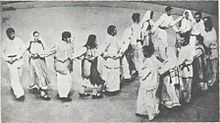 Kolo from Kozara mountain
Kolo from Kozara mountain
The traditional dance of Serbs is the kolo (in some regions oro), circle dance, of which dances are the same and similar to those of other Balkan peoples. It is a collective dance, where a group of people hold each other by the hands, forming a circle (kolo, hence the name), semicircle or spiral.
The Serbs are a highly family-oriented society. A peek into a Serbian dictionary and the richness of their terminology related to kinship speaks volumes.
As with many other peoples, there are popular stereotypes on the local level: in popular jokes and stories, inhabitants of Vojvodina (Lale) are perceived as phlegmatic, undisturbed and slow; Montenegrins are lazy and pushy; southern Serbians are misers; Bosnians are raw and stupid; people from Central Serbia are often portrayed as capricious and malicious, etc.
Another related feature, often lamented by Serbs themselves, is disunity and discord; as Slobodan Naumović puts it, "Disunity and discord have acquired in the Serbian popular imaginary a notorious, quasi-demiurgic status. They are often perceived as being the chief malefactors in Serbian history, causing political or military defeats, and threatening to tear Serbian society completely apart." That disunity is often quoted as the source of Serbian historic tragedies, from the Battle of Kosovo in 1389 to Yugoslav wars in 1990s.[61] Even the contemporary notion of "two Serbia's"—one supposedly national, liberal and Eurocentric, and the other conservative, nationalist and Euroskeptic—seems to be the extension of the said discord.[62] Popular proverbs "two Serbs, three political parties" and "God save us from Serbs that may unite!", and even the unofficial Serbian motto "only unity saves Serbs" (Samo sloga Srbina spasava) illustrate the national frustration with the inability to unite over important issues.
Christian customs
Of all Slavs and Orthodox Christians, only Serbs have the custom of slava. Slava is the celebration of a family's patron saint, a protector, which is inherited mostly, though not exclusively, paternally. The custom is believed to have its origin in pagan times, and is known to have been canonically introduced by Saint Sava, the first Serbian Archbishop (1217–1233). There are a total of 78 feast days, and each family has one patron saint only, which means that the occasion brings all of the family together.
Serbs have their own customs regarding Christmas. The Serbian Orthodox Church uses the Julian calendar, so Christmas currently falls on 7 January of the Gregorian calendar. Early in the morning of Christmas Eve, the head of the family would go to a forest in order to cut badnjak, a young oak, which is then brought into the church to be blessed by the priest. The tree is stripped of its branches and combined with wheat and other grain products to be burned in the fireplace. The burning of the badnjak is a ritual which is most certainly of pagan origin, and is considered a sacrifice to God so that the coming year may bring plenty of food, happiness, love, luck and riches. Nowadays, with most Serbs living in towns, most simply go to their church service to be given a small parcel of oak, wheat and other branches tied together to be taken home and set afire. The house floor and church is covered with hay, reminding worshippers of the stable in which Jesus was born.
Christmas Day itself is celebrated with a feast, necessarily featuring roasted piglet as the main meal. The most important Christmas meal is česnica, a special kind of bread. The bread contains a coin; during the lunch, the family breaks up the bread and the one who finds the coin is said to be assured of an especially happy year.
Christmas is not associated with presents like in the West, most Serbian families give presents on New Year's Day. Deda Mraz (literally Grandpa Frost, the Santa Claus) and the Christmas tree (but rather associated with New Year's Day) are also used in Serbia as a result of globalisation. Serbs also celebrate the Old New Year (currently on 14 January of the Gregorian Calendar).
History
History of Serbia 
This article is part of a seriesBy century 9th · 10th Prehistory Starčevo · Vinča · Scordisci · Triballi Roman (Illyria; Moesia · Pannonia · Dacia) Middle Ages Principality (768-969) (Rascia · Doclea · Zachlumia · Travunia · Pagania) Catepanate · Theme (969–1043) Vojislavljević Doclea (998–1101) Grand Principality (1101–1217) Kingdom (1217–1346) Empire (1346–1371) Fall · Lazar's Serbia (1371–1402) Despotate (1402–1459) Early modern Ottoman (1402–1912) Habsburg Kingdom of Serbia (1718–1739) Great Serb Migrations Modern Serbia Revolution (1804–1815) Principality of Serbia (1817–1882) Kingdom of Serbia (1882–1918) Yugoslavia (1918–1990/2006) German Occupation (1941–1944) Socialist Republic (1944–1990) Federal Republic, then State Union (1990–2006) Republic of Serbia (since 2006) Timeline
Serbia Portal
Main articles: History of Serbia and History of SerbsOrigin
Main article: Origin of the SerbsThe Slavs invaded Balkans during Justinian I rule (527–565), when eventually up to 100,000 Slavs raided Thessalonica. The Western Balkans was settled with "Sclaveni", the east with Antes.[63] Archaeological evidence in Serbia and Macedonia conclude that the White Serbs may have reached the Balkans earlier, between 550–600, as much findings; fibulae and pottery found at Roman forts, point at Serb characteristics.[64] The "White Serbs" mentioned by Porphyrogenitus could thus have been a fraction of these early Slavs.
According to Byzantine tradition, the Serbs (Σερβlοι) are recorded in the Empire with the arrival of the "Unknown Archont" and his White Serbs, who most likely hailed from Poland. The archon had led half of his people after the death of his father, a King, to the Balkans and asked Emperor Heraclius (r. 610–641) of protection. The Serbs lived briefly in the West Macedonian town of Servia (which has retained its name from the Serbs), then in Belgrade they requested a portion of land and were given the desolate lands of Western Balkans. The mentioned horions of the Serbs were: Rascia, Travunia, Zachlumia, Bosnia, Pagania and Doclea.[36]
The Slavs of the Empire lived in so-called Sklavinia, i.e. Slav lands. The Serbian Sklavinia is known to have stretched over modern south Serbia, Montenegro, Bosnia, Herzegovina and a large part of Dalmatia. The Slavs were administered into župe, a confederation of village communities headed by the local župan, a magistrate or governor. The power of the župan would subsequently emerge, and inherit an office similar to that of the strategoi.
The cultural ties with the Byzantine Empire contributed greatly to the Serbian ethnogenesis.
Middle Ages
Main article: Medieval Serbia"...Sorabos, quae natio magnam Dalmatiae partem obtinere dicitur..."
transl. "Serbs, who inhabit the greater part of Dalmatia"The first Serbian ruler, the same archon, died long before the Bulgar invasion (680). In 649 or 667, Emperor Constans II relocated Serbs from "around river Vardar" to Asia Minor (see Asia Minor Slavs). Some 30,000 soldiers in the city of Gordoservon (City of the Serbs), were to fight the Umayyad Caliphate, however they deserted the battlefield in 692 due to harsh treatment.[67] There is a gap in rulers until the coming of the first Serbian Prince known by name, Višeslav, who was a contemporary with Charlemagne (768–814). Višeslav's son, or grandson, ruled during the uprisings of Ljudevit Posavski against the Franks in 819–822. According to the Royal Frankish Annals, in 822, Ljudevit went from his seat in Sisak to the Serbs somewhere in western Bosnia – the Serbs are mentioned as controlling the greater part of Dalmatia ("Sorabos, quae natio magnam Dalmatiae partem obtinere dicitur").[65][66]
The Serbs and neighbouring Bulgars are known to have co-existed peacefully until the Bulgaro-Serbian Wars 839–842. The Bulgars had earlier conquered Timok, Braničevo and parts of Macedonia, and this prompted Prince Vlastimir to unite several tribes, which may have in turn prompted the Bulgars to invade. The invasion led to a three-year-war in which Serbia decisively won, the war ended with the death of the Emperor, which released Serbia from its obligations to the Empire.[68] Vlastimir was succeeded by his son, Mutimir, of which reign is characterized by yet another victory against the Bulgars, and most importantly – the Christianization of Serbs.[69][70] The Serbian fleet aided Basil I in his operation against the Saracens who sacked Ragusa in 869.[71] Mutimir had feuded with his two brothers, and the many succession wars of the throne were to be crucial in Serbia's fate as either a Byzantine or Bulgarian vassal.
In the 960s, Serbia was conquered by the Byzantines, the Catepanate of Serbia was established, ruled by John, protospatharios and katepano of Ras. In 1018, the Theme of Sirmium was established, at the same time, Serbian statehood was continued in Duklja.
In the time of the Comnenos, 1081–1180, Serbs served in the Byzantine Army.[72]
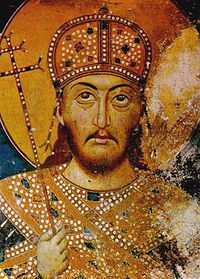 The most powerful Serbian archont, Emperor Stefan Dušan.
The most powerful Serbian archont, Emperor Stefan Dušan.
Serbia reached its golden age under the House of Nemanjić, with the Serbian state reaching its apogee of power in the reign of Tsar Stefan Uroš Dušan. The Serbian Empire lost its powers following Stefan's death and the contemporary incursion of the Ottoman Empire into south-eastern Europe frightened the Balkans. With Ottoman expansion into Europe with the fall of Adrianople and Thrace, Serbs together with Hungarians, Bulgarians, Greeks and others, tried their best for the Balkans integrity. The Turks gained more power, and in 1389, the Serbs fought them in the historical Battle of Kosovo, which is regarded as the key event in the loss of Serbia to the Ottoman Empire. By 1459, Serbia was beaten by the Turks, the small Serbian territories of Bosnia and Montenegro were lost by 1496.
Ottoman and Habsburg administration
As Christians, the Serbs were regarded as a "protected people" under Ottoman law, but were however referred to as Giaour (Serbian: Kaurin, Infidel). Many converted to Islam in viyalets where Islam was more powerful, notably in the Sandzak and Bosnia region, other converted in order to be more successful in the Ottoman Empire society and many were forced as part of Turkification or Islamisation and avoided persecution. The Janissaries (Serbian: Janjičari) were infantry units that served directly under the Sultan in the households and bodyguarding the higher people within the Ottoman Turkish government, they were composed of Islamicized Christian boys taken from the conquered countries through the Devşirme (Blood tribute) system, trained and schooled to serve the Ottoman Empire. Serbs, together with Greeks and Bulgarians were favored by the Sultans.
After the Siege of Belgrade, Suleiman I settled Serbs in the nearby forest of Istanbul, present day Bahçeköy, called Belgrade forest.[29]
The Serbs opposed the Ottoman yoke, which resulted in several major battles and rebellions against the Turks and de-population of Serbian lands through mass migrations (Known as "Great Serb Migrations"). Serbs in the south migrated to the north and sought refuge in Croatia and Hungary.
The Serbs of Montenegro were disliked because of their bravery and dignity to each other, unsatisfied with the situation in the region, they assassinated many deployed Turks in the mountains, which caused heavy monitoring of the Serb clans and hiding from the Turks was necessary, or else, death awaited. Years went on and the Austro-Hungarian Empire gained control in the north, which also threatened the dreams of a free state of the Serbs.
In Vojvodina, a Serb mercenary named Jovan Nenad proclaimed himself Emperor, defeating many Hungarian armies with his 15,000 men before being ambushed and killed in Szeged.
In Eastern Serbia, Serbs fought in Hajduk formations in the highlands against the Turks, a notable leader in the 16th century was Starina Novak, who fought as a captain of a 2,000 strong unit in the army of Michael the Brave and successfully liberated several Romanian and Bulgarian towns before being executed by Albanian Giorgio Basta.
Serbian Revolution and First World War
 Karadjordje Petrovic (Black George) leader of the First Serbian Uprising
Karadjordje Petrovic (Black George) leader of the First Serbian Uprising
The Serbs and Croats rebelled in Dalmatia and Slavonia in guerilla formations of Uskoks and Hajduks during the 17th, 18th and 19th centuries (prior to Independence). The Serbian revolution took place 1804–1835. The first part of the period, from 1804 to 1815, was marked by a violent struggle for independence from the Ottoman Empire, with two armed uprisings taking place. The later period (1815–1835) witnessed a peaceful consolidation of political power of the newly autonomous Serbia, culminating in the recognition of the right to hereditary rule by Serbian princes in 1830 and 1833 and the adoption of the first written constitution in 1835. These events marked the foundation of Modern Serbia. In 1852, the Principality of Montenegro was proclaimed, a nation-state of the Serbs.
At the beginning of the 19th century, the First Serbian Uprising succeeded in liberating at least some Serbs for a limited time. The Second Serbian Uprising was much more successful, resulting in Ottoman recognition of Serbia as autonomous principality within the Empire. Serbia acquired international recognition as an independent kingdom at the Congress of Berlin in 1878. However, many Serbs remained under foreign rule– that of the Ottomans in the south, and of the Habsburgs in the north and west. The southern Serbs were liberated in the First Balkan War of 1912, while the question of the Habsburg Serbs' independence was the spark that lit World War I two years later. During the war, the Serbian army fought fiercely, eventually retreating through Albania to regroup in Greece, and launched a counter-offensive through Macedonia. Though they were eventually victorious, the war devastated Serbia and killed a huge proportion of its population– by some estimates, over half of the male Serbian population died in the conflict, influencing the region's demographics to this day.
Yugoslavia
After the war, the Kingdom of Serbs, Croats and Slovenes (later called Yugoslavia) was created. Almost all Serbs finally lived in one state, in majority. The Kingdom had its capital in Belgrade and was ruled by a Serbian king; it was, however, unstable and prone to ethnic tensions.
During the Second World War, the Axis Powers occupied Yugoslavia and the German puppet states of Nedić's Serbia and the Independent State of Croatia were established. Serbs and Jews were subjected to systematic genocide in the territory of the Independent State of Croatia with 307,000 Serb deaths and 35–36,000 deaths of Jews.[73] In addition, an estimated 120,000 Serbs were deported from the Independent State of Croatia into Nedić's Serbia while an estimated 300,000 fled in 1943.[74] In Kosovo, between 70,000 and 100,00 Serbs were sent to concentration camps in an effort to Albanize the area.[74] Serbs largely fought in the resistance movements of the royalist Chetnik movement and the communist Yugoslav Partisan movement. The Chetniks, which increasingly collaborated with the Germans and Italians throughout the war, carried out massacres against the Croat and Muslim population of Bosnia and Herzegovina and Sandžak.[75] The Yugoslav Partisans established a multi-ethnic army that managed to seize control of Yugoslavia and create the Socialist Federal Republic of Yugoslavia. In the entirety of the war the Partisans in Bosnia were 64.1 percent Serb.[76] Overall, from 1941 to 1945, the Partisans in Croatia were 28% Serb.[77] It is estimated that a total of between 487,000 and 530,000 Serbs were killed in the war.[78]
After the war, the Socialist Federal Republic of Yugoslavia was formed. As with pre-war Yugoslavia, the country's capital was at Belgrade. Serbia was the largest republic and the Serbs were the largest ethnic group, existent in all republics. There were also two established autonomous provinces within Serbia – Kosovo (with an Albanian majority) and Vojvodina (with an Hungarian minority). Besides Serbia, the large Serb populations were concentrated in Bosnia and Herzegovina (where they were the largest ethnic group until 1971) and Croatia, as well as Montenegro (where they were majority until World War II).
Socialist Yugoslavia collapsed in the early 1990s, with four of its six republics becoming independent states. This led to several bloody civil wars, as the large Serbian communities in Croatia and Bosnia attempted to remain within Yugoslavia, then consisting of only Serbia and Montenegro. Serbs in Croatia formed the Republic of Serbian Krajina (RSK) in 1991, and Bosnian Serbs formed Republika Srpska in Bosnia and Herzegovina in 1992, subsequently expelling and killing the Croats and Muslims who lived within the self-declared borders and destroying Catholic Churches and mosques.[79][80][81][82] In 1995 the wars ended, with the Croatian army successfully launched two offensives to retake parts of the RSK resulting in a mass exodus of an estimated 150,000–200,000 Serbs, and the Bosnian army working with NATO to capture territory in Republika Srpska, resulting in the Dayton Peace Accords.[83]
Another war broke out in Kosovo (see Kosovo War) after years of tensions between Serbs and Albanians. Up to 250,000 Serbs fled from Croatia during the "Operation Storm" in 1995, and 300,000 left until 1993, and another 200,000 were expelled from Kosovo after the Kosovo War, and settled mostly in Central Serbia and Vojvodina as refugees.
Communities
In Serbia (the nation-state), 6.2 million Serbs constitute about 62% of the population (83% excluding Kosovo, see Status of Kosovo). Another 1,6 million live in Bosnia and Herzegovina,[84] where they are a constituent nation, predominantly living in Republika Srpska. In Montenegro (former nation-state), the minority numbers 201,892. The minority in Croatia numbers some 200,000 people (580,000 prior to the war, when they were a constituent nation). In the 1991 census Serbs consisted 39% of the overall population of former Yugoslavia; there were around 8.5 million Serbs in the entire country. Much smaller Serb autochthonous minorities exist in the Republic of Macedonia (mainly in Kumanovo and Skopje), Slovenia (Bela Krajina), Romania (Banat), Hungary (Szentendre, Pécs, Szeged) and Italy (Trieste – home to about 6,000 Serbs).[85]
The largest urban populations of Serbs in the former Yugoslavia are to be found in Belgrade (c. 1,700,000), Novi Sad (c. 300,000), Niš (c. 250,000), Banja Luka (in Bosnia and Herzegovina) (c. 220,000), Kragujevac (c. 175,000), East Sarajevo and Prijedor (in Bosnia and Herzegovina) (c. 130,000). All the capitals of the former Yugoslavia contain a strong historical Serbian minority – 10,000 strong and over (taking up anywhere between 2%- 3% of the population – Zagreb, Skopje – through Ljubljana and Sarajevo, and finally, Podgorica – over 26%).
The subgroups of Serbs are commonly based on regional affiliation. Some of the major regional groups include: Šumadinci, Ere, Vojvođani, Crnogorci, Kosovci, Bačvani, Banaćani, Bokelji, Bosanci, Sremci, Semberci, Krajišnici, Hercegovci, Shopi, etc (These also refer to any native inhabitant of the regions in question, regardless of ethnicity, i.e. to Magyar Vojvodinians or Croat Herzegovinians.). Serbs inhabiting Montenegro and Herzegovina are organized into clans.
Many Serbs also live in the diaspora, notably in Germany, Austria, the Netherlands, Switzerland, France, Sweden, Canada, the US and Australia. Abroad, Vienna is said to be home to the largest Serb population followed by Chicago (and its surrounding area) with Toronto and southern Ontario coming in third. Los Angeles and Indianapolis are known to have a sizable Serbian community, but so do Berlin, Paris, Moscow, Istanbul and Sydney. The number of Serbs in the diaspora is unknown but it is estimated to be up to 5.5 million.[86][87] Smaller numbers of Serbs live in New Zealand, and Serbian communities in South America (Argentina, Bolivia, Brazil and Chile) are reported to grow and exist to this day.
According to official figures, 5000 Serbs live in Dubai but the unofficial figure is estimated to be around 15,000.[88] Serbian immigrants went to the Persian Gulf states to find employment opportunities in the United Arab Emirates, Bahrain, Qatar and Kuwait in the 1990s and 2000s.[citation needed]
The recent research of the Ministry of Diaspora, showed that more than two thirds of Serbs abroad have plans of returning to Serbia, and almost one third is ready to do it immediately should they be given a good employment offer.[89] The same research shows that more than 25% of the Serb Diaspora has some specialization, i.e. master or PhD titles, while 45% of them have university degrees.[89]
Autochthonous communities:
- Serbia is the nation-state of the Serbs.
- In Bosnia and Herzegovina, Serbs are one of the three constitutive ethnic groups, the entity of Republika Srpska is home to the supermajority of Bosnian Serbs.
- In Montenegro, 32% of the population is Serb according to the 2003 census, they are a national minority, however in the 19th century Montenegro was a nation-state of the Serbs and they were the majority (~90%) until World War II.[90]
Autochthonous communities with minority status:
- In Croatia, Serbs are the largest national minority, scattered across the country. According to the 2001 Census, there were 201,631 Serbs in Croatia, down from the pre-war figure of 581,663,[91] a result of the Operation Oluja; the Croatian War. They were stripped of their constitutional status in 1990.
- In Macedonia, Serbs are a minority present in 16 municipalities, the largest being the Čučer-Sandevo Municipality (close to 28%) and Staro Nagoričane Municipality. They are found in the cities of Kumanovo and Skopje.
Serbian minorities exist in the following regions:
- In Hungary, Serbs are an officially recognized ethnic minority, numbering 7,350 people or 0.1% of population.[92] They are scattered in the southern part of the country. There are also some Serbs who live in the central part of the country – in bigger towns like Budapest, Szentendre, etc. The only settlement with an ethnic Serb majority in Hungary is Lórév on Csepel Island.
- In Romania, Serbs are located mostly within the Caraş-Severin County, where they constitute absolute majority in the commune of Pojejena (52.09%)[93] and a plurality in the commune of Socol (49.54%)[94] Serbs also constitute an absolute majority in the municipality of Sviniţa (87.27%)[95] in the Mehedinţi County. The region where these three municipalities are located is known as Clisura Dunării in Romanian or Banatska Klisura (Банатска Клисура) in Serbian. Officially recognized minority in Romania numbers 22,518 or 0.1% of the population (Census 2002).[96]
- In Albania, Serbs are not officially recognized as a minority. According to the latest national minority census in Albania (2000), there were around 2000 Serbs and Montenegrins (they are listed together as one ethnic group) in the country.[97] Domestic Serb-Montenegrin community claims the figure is around 25,000, while independent sources placed the figure at 10,000 in 1994.[98] Serbian sources estimate up to 30,000.
- Serbian community in Italy's city of Trieste dates back to the 18th century.[99] Local Serbs have erected one of the most prominent monuments in central Trieste: the Serbian Orthodox Church of Saint Spyridon (1854).[100]
- There is a small number of Serbs in Slovakia, mostly located in the southern town of Komárno, where they have been living since the 17th century.[101] There has also been a historic minority in Bratislava (Požun), where many Habsburg Serbs studied in the university. Their present number today is unknown but they are nevertheless recognized as an official minority.[31]
Bosnia and Herzegovina
Main article: Serbs of Bosnia and HerzegovinaSerbs are one of the three constitutive nations of Bosnia and Herzegovina, predominantly concentrated in the Republika Srpska entity, although many also live in the Federation of Bosnia and Herzegovina entity.
Bosnian War
Main article: Bosnian WarThe Government of BiH declared independence which was not accepted by the federal Serb controlled government of Yugoslavia, and what followed was the forming of the Serbian Autonomous Area of the Bosnian Frontier in the western Bosnian Frontier region of Bosnia and Herzegovina with its capital in Banja Luka, which was not recognised by the central government. SAO Bosnian Frontier made attempts to unite with the Autonomous Region of the Serbian Frontier in Croatia. The Serb political leadership martialled its own force assisted by the Yugoslav People's Army and declared independence from Bosnia and Herzegovina in late 1992. During this period there was notable support for the idea of a Greater Serbia being made reality, both within Bosnia and in Serbia proper. This ideology advocated the joining of Serb-poulated regions into a contiguous territory. BiH's Bosniak and Bosnian Croat dominated government did not recognize the new Serbian Republic of Bosnia and Herzegovina, whose president was Radovan Karadžić seated in Banja Luka.[citation needed] The Serb side accepted the proposed ethnic cantonization of Bosnia and Herzegovina (the Carrington-Cutileiro peace plan), as did the Bosniak and Bosnian Croat sides in Lisbon in 1992, in the hope that war would not break out. The Bosniak political leadership under President Alija Izetbegović of Bosnia and Herzegovina subsequently revoked the agreement refusing to decentralize the newly created country based on ethnic lines.[citation needed] The Bosnian War began.
Throughout most of the war the Serb side fought against both the Bosniak side and the Bosnian Croat side. During Bosniak-Croat hostilities the Serbs co-operated largely with the Croats. There were exceptions to this as well, as Serb forces were also allied with the pro-Yugoslav Bosniaks of the Autonomous Province of Western Bosnia under Fikret Abdić. During most of the war, the Serb Republic comprised around 70% of Bosnia and Herzegovina's soil. During the entire length of war the Army of the Serb Republic maintained the Siege of Sarajevo, allegedly in order to tie down the Bosnian Muslim (Bosniak) forces and resources in what was the capital of the Bosnian-Herzegovinian state.[citation needed] Serb Republic maintained close ties with the Republic of the Serb Frontier and received volunteers and supplies from the Federal Republic of Yugoslavia during the war. The Serb Republic received a large number of Serb refugees from other Yugoslav hotzones, particularly non-Serb held areas in Sarajevo, Herzeg-Bosnia and Croatia. In 1993, the Owen-Stoltenberg peace treaty was suggested that would give 52% of BiH to the Serb side. It was refused by the Bosniak side as too large of a concession. In 1994, the Federal Republic of Yugoslavia imposed sanctions after the National Assembly of the Serb Republic refused the Vance-Owen peace plan. In 1995, Operation Storm, eliminated the Republic of the Serb Frontier. The Croatian Army continued the offensive into the Serb Republic under General Ante Gotovina (currently on trial for war crimes at the ICTY). Some 250,000 Serbs fled to the Serb Republic and Serbia from Croatia,[citation needed] as the Serb side continued a full retreat of Serbs from the Una to the Sana river. The Croatian Army, supported by the forces of the Muslim-Croat Federation of Bosnia and Herzegovina came within 20 km of the de facto Bosnian Serb capital, Banja Luka. The war was halted with the Dayton Peace Agreement which recognized Republika Srpska, comprising 49% of the soil of BiH, as one of the two territorial entities of the Republic of Bosnia and Herzegovina. The Serb side suffered a total 30,700 victims – 16,700 civilians and 14,000 military personnel, according to the Demographic Unit at the ICTY.[citation needed] Although exact number are somewhat disputed, mostly by Bosniaks, it is generally agreed that the Bosnian War claimed the lives of about 100,000 people – Serbs, Croats and Bosniaks.[citation needed] See: Casualties of the Bosnian War
The demographics of Bosnia and Herzegovina as well as Republika Srpska were tremendously affected by the war. Current estimates indicate that some 400,000 Serbs no longer live in the Federation of BiH, the other entity in Bosnia which makes up 51% of its territory.[citation needed]
In Montenegro
Main article: Serbs of MontenegroThe term Montenegrin has traditionally been a geographical name for Serbs of Montenegro.
Serbs are native to Montenegro, where they have constituted a supermajority up until World War I (1909 census: 95%).[102] The Principality of Montenegro was a declared nation-state of Serbs. The number of Serbs have since changed due to shifts in national identity during the Yugoslav monarchy and federation, and since the dissolution and independence in 2006. In 1948, after the forming of Socialist Yugoslavia and the Montenegrin nationality, the percentage of declared Serbs was 1.78%, In 1991, it was 9.35%, and in 2003 it reached 32%.[102] The 2011 census show less fluctuations than previous polls, with a slight change to 29%.[103]
In Croatia
Main article: Serbs of CroatiaThe Serbs settled Dalmatia in the first decades of the 7th century, with the Neretva becoming a natural border of the two nations of Serbia and Croatia. In the 9th and 10th centuries, several Serbian royal members took refuge in Croatia after several succession wars (among Petar Gojniković), and a large wave of people entered Croatia after the Bulgarian annexation of Serbia in 924–927. Three medieval Serbian principalities held territories of present-day Croatia: Narentia, Zachumlia and Travunia. Beloš Vukanović was the Ban of Croatia 1142–1158 and 1163, in which time both Serbia and Croatia was in Hungarian alignment, although Croatia served as a vassal.
Several Serbian monasteries have been built in Croatia since the 12th century: Krka, Krupa, Dragović, Lepavina and Gomirje.
A large number of ethnic Serbs migrated in 1530s when Habsburg Ferdinand I offered sanctuary and permanent settlement to displaced Serbs from Old Serbia region (Montenegro, Kosovo, Macedonia, southern Serbia) fleeing from the Turks, placing them under Austrian military administration. The newly established military region was called Militärgrenze or Vojna Krajina. The Krajina Serbs joined the Austrian army, established the hajduk and uskok units that raided and pillaged Turkish settlements across the border into Ottoman Serbia.
After the First World War, the Kingdom of Serbs, Croats and Slovenes (renamed Yugoslavia) was created. Almost all Serbs finally lived in one state, in majority. The Kingdom had its capital in Belgrade and was ruled by the Serbian king.
During the Second World War, the Serbs suffered greatly in Croatia after the Axis Fascist Ustasha regime came into power. The Ustaše aimed at an ethnically "pure" Croatia, and saw the Serbs that lived in Croatia, Bosnia and Herzegovina as the their biggest obstacle. Thus, Ustaše ministers Mile Budak, Mirko Puk, and Milovan Žanić declared in May 1941 that the goal of the new Ustaše policy was an ethnically clean Croatia. They also publicly announced the strategy to achieve their goal:
- One third of the Serbs (in the Independent State of Croatia) were to be forcibly converted to Catholicism.
- One third of the Serbs were to be expelled (ethnically cleansed).
- One third of the Serbs were to be killed (in extermination camps).
The Ustaše persecuted the Serbs who were mostly Orthodox Christians in several concentration camps, mass killings in Serb populated town and forced conversion[104] was systematically enacted, race laws patterned after those of the Third Reich were officially adopted, which were aimed against Jews, also the Roma and Serbs, who were collectively declared enemies of the Croatian people.
Estimates of the number of Serbian victims of genocide in Croatia are placed at least 500,000 people, The estimated number of Serbs killed in the Jasenovac concentration camp ranges from 300,000 to 700,000.
The people of Yugoslavia that opposed the Fascists and Nazis were the Partizan and Chetnik forces, the Partizans were led by Josip Broz Tito (later life-long President of Yugoslavia) composed of any ethnic people wanting to liberate the Balkans and the Chetniks who were a royalist unit composed of Serbs.
- 1931–633,000 Serbs out of 3,430,270 people in Croatia (18.45%)
War in Croatia
Main article: Croatian War of IndependenceFurther information: Republic of Serbian KrajinaThe War in Croatia, began when Serbs in Croatia who were opposed to Croatian independence announced their secession from Croatia in June 1991.[citation needed] Fighting in this region had actually begun weeks prior to the Ten-Day War in Slovenia. The move was in part triggered by a provision in the new Croatian Constitution that replaced the explicit reference to Serbs or "Croats of the Serbian Orthodox faith" in Croatia as a "constituent nation" with a generic reference to all other nations, and was interpreted by Serbs as being reclassified as a "national minority".[citation needed] The Serbian community of Krajina whom outnumbered Croats there 5 to 1[citation needed] was an independent republic from July 1991 to Oct. 1995 when they finally fell to the Croatian army.
In Kosovo
Main article: Serbs of KosovoSee also: Kosovo WarSerbs are the second largest ethnic group in Kosovo[a]. By the 12th century, the cultural, diplomatic and religious core of the Serbian Kingdom was located in Kosovo. This became essential to the Serbian Empire of the 14th century.
During the 20th century Serbian population constantly decreased. Their share in the overall population of the region is currently estimated at 7% by the CIA.[105] Serbs today mostly populate the enclaves across Kosovo, North Kosovo being the largest one.
Large-scale emigration of ethnic Serbs, especially since 1999 onwards, makes them the only major ethnic group in Kosovo to have a negative natural growth rate with deaths exceeding births.[106] BBC reports that less than 100,000, 5% Serbs remained in Kosovo following a post-war exodus of non-Albanians.[107] The Serbian minority live in separate areas watched over by NATO peacekeepers. International diplomats have voiced concern over slow progress on their rights. Human Rights Watch points out discrimination against Serbs and Roma in Kosovo.[108]
Diaspora
Main article: Serbian diasporaThere are currently 3.5 million Serbs in diaspora throughout the world (those that are not constitutional peoples; like in Serbia, Montenegro and Bosnia and Herzegovina in this case)[citation needed]. The Serb diaspora was the consequence of either voluntary departure, coercion and/or forced migrations or expulsions that occurred in six big waves:
- To the west and north, caused mostly by the Ottoman Turks.[citation needed]
- To the east (Czechoslovakia, Russia, Ukraine and across the former USSR from World War I and World War II, to until the fall of Communism in Eastern Europe by the early 1990s).[citation needed]
- To the USA for economic reasons, but Serbians also migrated to Canada, Australia, New Zealand, and South America.[citation needed]
- During wartime, particularly World War II and post-war political migration, predominantly into overseas countries (large waves of Serbians and other Yugoslavians into the USA, Great Britain, Canada, Australia and New Zealand).[citation needed]
- Going abroad for temporary work as "guest workers" and "resident aliens" who stayed in their new homelands during the turbulent 1960s and 1970s (to Austria, Belgium, Denmark, France, Germany, Greece, Italy, the Netherlands, Portugal, Spain, Sweden and the United Kingdom), however some Serbians returned to Yugoslavia in the 1980s.[citation needed]
- Escaping from the uncertain situation (1991–1995) caused by the dissolution of Yugoslavia, the renewal of vicious ethnic conflicts and civil war, as well as by the disastrous economic crises, which largely affected the educated or skilled labor forces (i.e. "brain drain"), increasingly migrated to Western Europe, North America and Australia/New Zealand.[citation needed]
The existence of the centuries-old Serb or Serbian diaspora in countries such as Austria, Czech Republic, Greece, Hungary, Italy, Romania, Russia, Poland, Slovakia, Turkey and Ukraine, is the result of historical circumstances – the migrations to the North and the East, due to the Turkish conquests of the Balkans and as a result of politics, especially when the Communist Party came into power, but even more when the communist state of Yugoslavia collapsed into inter-ethnic conflict, resulting in mass expulsions of people from certain regions as refugees of war. Although some members of the Serbian diaspora do not speak the Serbian language nor observe Christianity (some Serbians are Jews, Slavic Muslims, Protestants, Roman Catholics, Eastern Rite Catholics, or atheists) or members of the overseas dioceses of the Serbian Orthodox Church, they are still traditionally regarded as Serbs or Serbians other than Yugoslavians or Yugoslavs.[citation needed]
See also
- Serbia, nation-state of Serbs
- List of notable Serbs
- states, regions, territories of Serbs
- Serb clans, former feudal organizations of Montenegro and Herzegovina
- Yugoslavs, national demonym and umbrella term of the peoples of the Yugoslav federation
- Slavs; Medieval Slav tribes; South Slavs
Notes
- ^ "CIA - The World Factbook - Bosnia and Herzegovina". https://www.cia.gov/library/publications/the-world-factbook/geos/bk.html.
- ^ see Demographics of Croatia
- ^ "Census of Population, Households and Dwellings in Montenegro 2011". July 12, 2011. http://www.monstat.org/userfiles/file/popis2011/saopstenje/saopstenje(1).pdf. Retrieved 13 July 2011.
- ^ "The Euromosaic study - Other languages in Slovenia". European Commission. http://ec.europa.eu/education/policies/lang/languages/langmin/euromosaic/slov4_de.html.
- ^ Државен завод за статистика: Попис на населението, домаќинствата и становите во Република Македонија, 2002: Дефинитивни податоци (PDF)
- ^ Greece national statistical service: Statistics of Greece 2002
- ^ Life of Serbs in Albania, 2008-10-03
- ^ The Germany-Serbia remittance corridor
- ^ a b Serben-Demo eskaliert in Wien
- ^ "Erstmals über eine Million EU- und EFTA Angehörige in der Schweiz". Neue Zürcher Zeitung. 14. Oktober 2008. http://www.nzz.ch/nachrichten/schweiz/erstmals_ueber_eine_million_eu-_und_efta-angehoerige_in_der_schweiz__1.1105409.html.
- ^ Nordstrom, p. 353. (Serbia and Iran as top two countries in terms of immigration beside "Other Nordic Countries," based on Nordic Council of Ministers Yearbook of Nordic Statistics, 1996, 46-47)
- ^ Présentation de la République de Serbie
- ^ Statistiche demografiche ISTAT
- ^ The Serbian Council of Great Britain
- ^ Joshua Project: Ethnic groups in Denmark
- ^ Agenţia Naţionala pentru Intreprinderi Mici si Mijlocii: Recensamânt România 2002
- ^ "Etrangers inscrits dans tous les registres (1,2,3,4 et 5) du registre national - Remarque : Une nationalité "d'origine" désigne un réfugié politique reconnu". Statistiques Population étrangère. date=2 January 2008. http://www.dofi.fgov.be/fr/statistieken/statistiques_etrangers/Stat_ETRANGERS.htm.
- ^ Anuario Estadístico de España 2008. Instituto Nacional de Estadística. Population figures include Montenegro-born migrants.
- ^ http://www.ssb.no/english/subjects/00/minifakta_en/en/
- ^ "Statistiques - 01.06.2008". Government of Luxembourg. http://www.ecp.public.lu/repertoire/stats/2008/06/index.html.
- ^ Hungarian Central Statistical Office: Population by languages spoken with family members or friends, affinity with nationalities' cultural values and sex
- ^ Joshua Project: Ethnic groups of Turkey
- ^ Федеральная служба государственной статистики: 4.1. Национальный состав населения
- ^ "Selected Population Profile: Serbian". US Census Bureau. 2007. http://factfinder.census.gov/servlet/IPTable?_bm=y&-reg=ACS_2007_1YR_G00_S0201:558;ACS_2007_1YR_G00_S0201PR:558;ACS_2007_1YR_G00_S0201T:558;ACS_2007_1YR_G00_S0201TPR:558&-qr_name=ACS_2007_1YR_G00_S0201&-qr_name=ACS_2007_1YR_G00_S0201PR&-qr_name=ACS_2007_1YR_G00_S0201T&-qr_name=ACS_2007_1YR_G00_S0201TPR&-ds_name=ACS_2007_1YR_G00_&-TABLE_NAMEX=&-ci_type=A&-redoLog=false&-charIterations=424&-geo_id=01000US&-geo_id=NBSP&-format=&-_lang=en. Retrieved 2009.
- ^ The Canadian Encyclopedia
- ^ Australian Bureau of Statistics
- ^ "Ethnologue - South Slavic languages". www.ethnologue.com. http://www.ethnologue.com/show_family.asp?subid=373-16. Retrieved 2011-02-08.
- ^ "More than 2 million Serbs in region", B92, 11 February 2011
- ^ a b "Verovali ili ne: U Turskoj Živi 9 Miliona Srba!", Press Online Serbia
- ^ 2000 Census, US Census Bureau.
- ^ a b Blis.rs, Srbi u Slovackoj nacionalna manjina
- ^ Serbien-Montenegro.de | Serben in Deutschland
- ^ "Demographics of Luxembourg". Ithelp.us. http://ithelp.us/Luxembourg/?p=5. Retrieved 5 November 2011.
- ^ Serbien-Montenegro.de
- ^ "Slavyane v rannem srednevekovie" Valentin V. Sedov (Russian language), Archaeological institute of Russian Academy of Sciences, Moscow, 1995
- ^ a b c d De Administrando Imperio
- ^ a b c d e f Marijana Peričić et al. (2005). "High-Resolution Phylogenetic Analysis of Southeastern Europe Traces Major Episodes of Paternal Gene Flow Among Slavic Populations". Molecular Biology and Evolution 22(10). doi:10.1093/molbev/msi185 PMID 15944443.
N.B. The haplogroups' names in the section "Genetics" are according to the nomenclature adopted in 2008, as represented in Vincenza Battaglia (2008) Figure 2, so they may differ from the corresponding names in Marijana Peričić (2005). - ^ a b c D. Marjanovic et al. (2005). "The Peopling of Modern Bosnia-Herzegovina: Y-chromosome Haplogroups in the Three Main Ethnic Groups". Annals of Human Genetics 69. doi:10.1111/j.1529-8817.2005.00190.x PMID 16266413.
- ^ a b c d Battaglia, Vincenza et al. (2008). "Y-chromosomal evidence of the cultural diffusion of agriculture in southeast Europe". European Journal of Human Genetics 17 (6): 6. doi:10.1038/ejhg.2008.249. PMC 2947100. PMID 19107149. http://www.pubmedcentral.nih.gov/articlerender.fcgi?tool=pmcentrez&artid=2947100.
- ^ Klyosov, Anatole (2009). "DNA Genealogy, Mutation Rates, and Some Historical Evidence Written in the Y-Chromosome, Part II: Walking the Map" (PDF). Journal of Genetic Genealogy 5 (2). http://www.jogg.info/52/files/Klyosov1.pdf.
- ^ Peter A Underhill et al. (2009). "Separating the post-Glacial coancestry of European and Asian Y chromosomes within haplogroup R1a". European Journal of Human Genetics. doi:10.1038/ejhg.2009.194 PMID 19888303.
- ^ Natalie M Myres et al. (2011). "A major Y-chromosome haplogroup R1b Holocene era founder effect in Central and Western Europe". European Journal of Human Genetics 19. doi:10.1038/ejhg.2010.146.
- ^ Krzysztof Rębała et al. (2007). "Y-STR variation among Slavs: evidence for the Slavic homeland in the middle Dnieper basin". Journal of Human Genetics 52. doi:10.1007/s10038-007-0125-6 PMID 17364156.
- ^ Mikić Živko (1994). "Beitrag zur Anthropologie der Slawen auf dem mittleren und westlichen Balkan". Balcanica". (Belgrade: The Institute for Balkan Studies of the Serbian Academy of Sciences and Arts) 25: 99–109.
- ^ a b c Ćirković, Sima M., and Vuk Tošić. The Serbs, p. 13. Vuk Tošić (ed. and trans.). Hoboken, N.J.: Wiley-Blackwell, 2004, p. xii. ISBN 978-0-631-20471-8.
- ^ Ivo Vukcevich, Rex germanorum, populos sclavorum, p. 73: "Zupanic believes that the montes Serrorum can be traced to early Serb settlements in Dacia: Since we have shown that Serri is the same as Serb, the montes Serrorum mentioned by Marcellinus confirms the presence of Serbs" Google Book
- ^ a b The Spread of the Slaves, by Henry Hoyle Howorth, Journal of the Anthropological Institute, 1878
- ^ Our forefathers, Google Book
- ^ Istorija Srba, Chapter 5: "Slovenska plemena i njihova kultura"
- ^ Povest vremennih let (Moscow, Leningrad: Akademiya nauk SSSR, 1990), pp.11, 207.
- ^ "Projekat Rastko – Luzica / Project Rastko – Lusatia". Rastko.rs. http://www.rastko.rs/rastko-lu/jezik/hsuster-srbin.html. Retrieved 5 November 2011.
- ^ J.P. Mallory and D.Q. Adams, "Protect", The Encyclopedia of Indo-European Culture (London: Fitzroy and Dearborn, 1997).
- ^ p. 97. Google Books. http://books.google.com/?id=dPBPHVf3kdoC&pg=PA97. Retrieved 5 November 2011.
- ^ The Serbs, p. 25
- ^ Anne Comnene, Alexiade (Regne de L'Empereur Alexis I Comnene 1081–1118) II, pp. l57:3-l6; 1.66: 25–169. Texte etabli er traduit par B. Leib t. I-III (Paris, 1937–1945).
- ^ Rescriptum Declaratorium Illyricae Nationis, 1779, by Maria Theresa, establishing rights and recognition of the Serbian Orthodox Church in the Empire
- ^ Jstor Article
- ^ Milenko Vukic, Znameniti Srbi-muslimani
- ^ Lybyer, Albert Howe, The government of the Ottoman empire in the time of Suleiman the Magnificent, (Harvard University Press, 1913), 63–64.
- ^ "Byzantine Empire". Crwflags.com. http://www.crwflags.com/fotw/flags/gr_byz.html. Retrieved 5 November 2011.
- ^ Slobodan Naumović (PDF). The social origins and political uses of popular narratives on Serbian disunity. Filozofija i društvo 2005 Issue 26, Pages: 65–104. http://www.doiserbia.nb.rs/img/doi/0353-5738/2005/0353-57380526065N.pdf. Retrieved 2009-06-22.
- ^ Branko Radun (2007-03-10). "Dve zadušnice za "dve Srbije"". Nova srpska politička misao. http://www.nspm.org.yu/koment_2007/2007_radun2.htm. Retrieved 2007-06-05.
- ^ Hupchick, Dennis P. The Balkans: From Constantinople to Communism. Palgrave Macmillan, 2004. ISBN 1-4039-6417-3
- ^ "Пројекат Растко: Đorđe Janković : The Slavs in the 6th century North Illyricum". Rastko.rs. http://www.rastko.rs/arheologija/delo/13047. Retrieved 5 November 2011.
- ^ a b Serbian studies, Volumes 2–3, p. 29
- ^ a b Eginhartus de vita et gestis Caroli Magni, p. 192: footnote J10
- ^ Erdeljanovich.J. "O naseljavanju Slovena u Maloj Aziji i Siriji od VII do X veka" Glasnik geografskog drushtva vol. VI 1921 pp.189
- ^ Fine 1991, pp. 108–110
- ^ Fine 1991, pp. 141
- ^ The entry of the Slavs into Christendom, pp. 208–209
- ^ V. Corovic, Istorija Srba, 2:4, Rastko article
- ^ The development of the Komnenian army: 1081–1180. Books.google.se. http://books.google.se/books?id=p8OOoGWRC2EC. Retrieved 5 November 2011.
- ^ Ramet, Sabrina P. (2006). The Three Yugoslavias: State-Building and Legitimation, 1918–2004. Indiana University Press. p. 119. ISBN 0271016299.
- ^ a b Ramet, Sabrina P. (2006). The Three Yugoslavias: State-Building and Legitimation, 1918–2004. Indiana University Press. p. 114. ISBN 0271016299.
- ^ Tomasevich, Jozo (1975). War and Revolution in Yugoslavia, 1941–1945: The Chetniks. Stanford University Press. pp. 258–259. ISBN 0804708576.
- ^ Hoare, Marko Attila (2006). Genocide and Resistance in Hitler's Bosnia: The Partisans and the Chetniks. Oxford University Press. pp. 143–147. ISBN 0197263801.
- ^ Cohen, Philip J.; Riesman, David (1996). Serbia's Secret War: Propaganda and the Deceit of History. Texas A&M University Press. p. 95. ISBN 0890967601.
- ^ Žerjavić, Vladimir. YUGOSLAVIA-MANIPULATIONS -WITH THE NUMBER OF SECOND WORLD WAR VICTIMS. Croatian Information Centre. ISBN 0-919817-32-7. http://www.hic.hr/books/manipulations/index.htm.
- ^ Bassiouni, Cherif (27 May 1994). "Final report of the United Nations Commission of Experts established pursuant to security council resolution 780". United Nations. http://www.ess.uwe.ac.uk/comexpert/ANX/VI-01.htm. Retrieved 10 May 2010.
- ^ ICTY evidence; Babic pleads guilty to crimes
- ^ Croatian refugees[dead link]
- ^ "Vukovar death toll". Iwpr.net. http://www.iwpr.net/?p=tri&s=f&o=325671&apc_state=henh. Retrieved 5 November 2011.
- ^ "Dayton Peace Accords on Bosnia". US Department of State. 30 March 1996. http://www.state.gov/www/regions/eur/bosnia/bosagree.html. Retrieved 19 March 2006.
- ^ "CIA – The World Factbook". Cia.gov. https://www.cia.gov/library/publications/the-world-factbook/geos/bk.html. Retrieved 5 November 2011.
- ^ The Independent, "Trieste: In the wake of James Joyce"
- ^ "The Serbian Pressure Groups On Global Scale". Rieas.gr. http://rieas.gr/index.php?option=com_content&task=view&id=763&Itemid=41. Retrieved 5 November 2011.
- ^ serbianna. "Ioannis Michaletos Column on Serbianna.com | Front Page". Serbianna.com. http://www.serbianna.com/columns/michaletos/038.shtml. Retrieved 5 November 2011.
- ^ Miloš Rajković (2007-04). "Maqamat of New Babylon". Jat Airways. http://www.jat.com/active/en/home/main_menu/travel_info/jat_review/april_2007/makame_iz_novog_vavilona.html. Retrieved 2007-09-23.
- ^ a b "Press Review". glassrbije.org. 29 December 2008. http://glassrbije.org/E/index.php?option=com_content&task=view&id=5690&Itemid=31. Retrieved 5 November 2011.
- ^ "Montenegro". State.gov. 26 August 2011. http://www.state.gov/r/pa/ei/bgn/70949.htm. Retrieved 5 November 2011.
- ^ "Population of Croatia 1931–2001". Vojska.net. http://www.vojska.net/eng/armed-forces/croatia/about/population/. Retrieved 5 November 2011.
- ^ [1][dead link]
- ^ "Structura Etno-demografică a României". Edrc.ro. 26 October 2011. http://www.edrc.ro/recensamant.jsp?regiune_id=1832&judet_id=1909&localitate_id=1965. Retrieved 5 November 2011.
- ^ "Structura Etno-demografică a României". Edrc.ro. 26 October 2011. http://www.edrc.ro/recensamant.jsp?regiune_id=1832&judet_id=1909&localitate_id=1974. Retrieved 5 November 2011.
- ^ "Structura Etno-demografică a României". Edrc.ro. 26 October 2011. http://www.edrc.ro/recensamant.jsp?regiune_id=1407&judet_id=1579&localitate_id=1638. Retrieved 5 November 2011.
- ^ "Vinde mai mult! > Articole InfoAfaceri > Recensamant Romania 2002". ClubAfaceri.ro. http://www.clubafaceri.ro/info_articole/articol/1294. Retrieved 5 November 2011.
- ^ untitled[dead link]
- ^ "Serbs – Stateless Nations, national, cultural and linguistic minorities, native peoples, ethnic groups in Europe". Eurominority. http://www.eurominority.org/version/eng/minority-detail.asp?id_states=1&id_minorities=219. Retrieved 5 November 2011.
- ^ "Jason Cowley". Jason Cowley. 25 June 2000. http://www.jasoncowley.net/essays/E20000625_I.html. Retrieved 5 November 2011.
- ^ "Listing of Serbian Orthodox Churches by Country". Serbian Orthodox Church. http://www.serbianorthodoxchurch.com/pages/listing/country/index.html. Retrieved 5 November 2011.
- ^ "The Pride of Komarno". Slovakheritage.org. http://slovakheritage.org/Townsvill/komarnopride.htm. Retrieved 5 November 2011.
- ^ a b "Montenegrin Census' from 1909 to 2003 – Aleksandar Rakovic". Njegos.org. 23 September 2004. http://www.njegos.org/census/index.htm. Retrieved 5 November 2011.
- ^ http://www.monstat.org/userfiles/file/popis2011/saopstenje/saopstenje(1).pdf
- ^ "Manfred and Anne Lehmann Foundation". Manfredlehmann.com. http://www.manfredlehmann.com/sieg457.html. Retrieved 5 November 2011.
- ^ "CIA – The World Factbook". Cia.gov. https://www.cia.gov/library/publications/the-world-factbook/geos/kv.html. Retrieved 5 November 2011.
- ^ "CIA World Factbook". https://www.cia.gov/library/publications/the-world-factbook/geos/kv.html. Retrieved 2008-08-24.
- ^ "Regions and territories: Kosovo". BBC News. 2009-11-20. http://news.bbc.co.uk/2/hi/europe/country_profiles/3524092.stm. Retrieved 2010-05-23.
- ^ "Human Rights Watch: Abuses Against Serbs And Roma In The New Kosovo (August 1999)". Hrw.org. http://www.hrw.org/reports/1999/kosov2/. Retrieved 5 November 2011.
Sources
Overall:
- Ćorović, Vladimir, Istorija srpskog naroda, Book I, (In Serbian) Electric Book, Rastko Electronic Book, Antikvarneknjige (Cyrillic)
- The Serbs, ISBN 0631204717, 9780631204718. Wiley-Blackwell, 2004, Google Books.
Medieval history:
- Constantine Porphyrogenitus, De Administrando Imperio, edited by Gy. Moravcsik and translated by R. J. H. Jenkins, Dumbarton Oaks Center for Byzantine Studies, Washington D. C., 1993
- Fine, John Van Antwerp (1991). The Early Medieval Balkans: A Critical Survey from the Sixth to the Late Twelfth Century. Michigan: The University of Michigan Press. ISBN 0472081497.
- Fine, John Van Antwerp (1994). The Late Medieval Balkans: A Critical Survey from the Late Twelfth Century to the Ottoman Conquest. Michigan: The University of Michigan Press. ISBN 0472082604, 0472100793.
- Tibor Živković, Portreti srpskih vladara (IX—XII), Beograd, 2006 (ISBN 86-17-13754-1)
- Vlasto, A. P. (1970). The Entry of the Slavs into Christendom: An Introduction to the Medieval History of the Slavs. Cambridge: Cambridge University Press. ISBN 0521074592, 9780521074599.
External links
Serbian diaspora Ex-Yugoslavia 
Europe Americas Canada (Toronto) • Latin America • United StatesOceania Ethnic groups in Serbia Central Serbia Serbs · Albanians · Bosniaks · Ethnic Muslims · Bulgarians · Croats · Macedonians · Montenegrins · Roma · Romanians (Vlachs) · YugoslavsVojvodina Banat Bulgarians · Bunjevci · Croats (Šokci) · Germans (Danube Swabians and Banat Swabians) · Hungarians (Szekelys) · Montenegrins · Macedonians · Pannonian Rusyns · Roma · Serbs · Slovaks · Yugoslavs · Romanians · Czechs · Slovenes · Gorani people · Ukrainians · Albanians · RussiansKosovo[a] ^a Kosovo is the subject of a territorial dispute between the Republic of Serbia and the self-proclaimed Republic of Kosovo. The latter declared independence on 17 February 2008, while Serbia claims it as part of its own sovereign territory. Its independence is recognised by 85 UN member states.Slavic ethnic groups East Slavs 
West Slavs South Slavs Bosniaks (Muslims by nationality) • Bulgarians (Gorani • Pomaks) • Croats (Bunjevci • Burgenland Croats • Janjevci • Krašovani • Molise Croats • Šokci) • Macedonians • Montenegrins • Serbs • SlovenesEastern and Oriental Orthodox Christian Ethnic Groups Majority EuropeanArmenians · Aromanians · Belarusians · Bulgarians · Georgians · Greeks (including Greek Cypriots) · Macedonians · Megleno-Romanians · Moldovans · Montenegrins · Ossetians · Romanians · Russians · Serbs · UkrainiansAfro-AsiaticAltaicUralicChukotko-KamchatkanMinority Categories:- Serb people
- Serbian people
- Slavic ethnic groups
- Slavic nations
- South Slavs
- Ethnic groups in Europe
- Ethnic groups in Montenegro
- Ethnic groups in Serbia
- Ethnic groups in Bosnia and Herzegovina
- Ethnic groups in Croatia
- Ethnic groups in the Republic of Macedonia
- Ethnic groups in Hungary
- Ethnic groups in Romania
- Ethnic groups in Slovenia
- Serbian society
Wikimedia Foundation. 2010.

